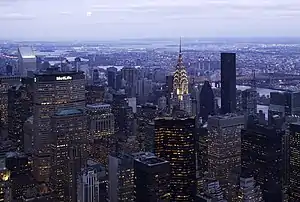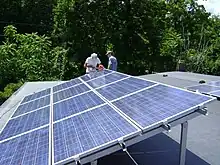Economy of New York (state)
The economy of the State of New York is reflected in its gross state product in 2022 of $2.053 trillion, ranking third in size behind the larger states of California and Texas. If New York State were an independent nation, it would rank as the 10th largest economy in the world. However, in 2019, the multi-state, New York City-centered metropolitan statistical area produced a gross metropolitan product (GMP) of $US2.0 trillion, ranking first nationally by a wide margin and would also rank as the 10th largest GDP in the world.

_counties_by_GDP_(2021).png.webp)
 | |
| Statistics | |
|---|---|
| GDP | $2.1 trillion (2022)[1] |
GDP per capita | $104,343 (2022)[2] |
Population below poverty line | 13.6%[3] |
| 0.502[4] | |
Labour force | 9,633,503 (2018)[5] |
| Unemployment | 4.1% (March 2023)[6] |
| Public finances | |
| Revenues | $63.5 billion[7] |
| Expenses | $54.6 billion[8] |
The state has a large manufacturing sector, which includes printing and publishing and the production of garments, furs, railroad rolling stock, and bus line vehicles. Some industries are concentrated in upstate locations also, such as ceramics and glass (the southern tier of counties), microchips and nanotechnology (Albany) and the Greater Capital District, and photographic equipment (Rochester). New York's agricultural outputs comprise dairy products, cattle and other livestock, vegetables, nursery stock, and apples. In April 2021, GlobalFoundries, a company specializing in the semiconductor industry, moved its headquarters from Silicon Valley, California to its most advanced semiconductor-chip manufacturing facility in Saratoga County near a section of the Adirondack Northway, in Malta, New York.[9]
New York City


New York City, characterized as the world's premier financial center,[13][14][15][11] and the surrounding New York metropolitan area dominate the economy of the state. Manhattan is the leading center of banking, finance, and communication in the United States and is the location of the New York Stock Exchange (NYSE) on Wall Street. Many of the world's largest corporations locate their home offices in Manhattan or in nearby Westchester, Nassau, and Suffolk counties. Manhattan contained over 500 million square feet (46.5 million m2) of office space in 2015,[16] making it the largest office market in the United States,[17] while Midtown Manhattan, with nearly 400 million square feet (37.2 million m2) in 2015,[16] is the largest central business district in the world.[18] New York is a top-tier global high technology hub.[19]
Long Island
Long Island has played a prominent role in scientific research and in engineering. It is the home of the Brookhaven National Laboratory. Seven Nobel prizes have been awarded for work conducted at Brookhaven lab.[20]
Agriculture

The Erie Canal, completed in 1825, opened eastern markets to Midwest farm products. The canal also contributed to the growth of New York City, helped create large cities, and encouraged immigration to the state. Except in the mountain regions, the areas between cities are agriculturally rich. The Finger Lakes region has orchards producing apples, which are one of New York's leading crops.[21] The state is known for wines produced at vineyards in the Finger Lakes region and Long Island. The state also produces other crops, especially grapes, strawberries, cherries, pears, onions, and potatoes. New York is a major supplier of maple syrup and is the third leading producer of dairy goods in the United States.[22]
According to the Department of Agriculture and Markets, New York's agricultural production returned more than $3.6 billion to the farm economy in 2005. 36,000 farms occupy 7.6 million acres or about 25 percent of the state's land area, to produce a variety of food products.[22] Here are some of the items in which New York ranks high nationally:
New York is an agricultural leader and is one of the top five states for agricultural products, including dairy, cattle, apples, cabbages, potatoes, beets, viticulture, onions, maple syrup and many others.[23] The state is the second largest producer of cabbage in the U.S.[22] The state has about a quarter of its land in farms and produced $3.4 billion in agricultural products in 2001. The south shore of Lake Ontario provides the right mix of soils and microclimate for apple, cherry, plum, pear and peach orchards. Apples are also grown in the Hudson Valley and near Lake Champlain. The south shore of Lake Erie and the southern Finger Lakes hillsides have vineyards. New York is the nation's third-largest grape-producing state, after California and Washington.[22]
Energy
In 2017, New York State consumed 156,370-gigawatthours (GWh) of electrical energy. Downstate regions (Hudson Valley, New York City, and Long Island) consumed 66% of that amount. Upstate regions produced 50% of that amount. The peak load in 2017 was 29,699 MW. The resource capability in 2017 was 42,839 MW.[24][25] The NYISO's market monitor described the average all-in wholesale electric price as a range (a single value was not provided) from $25 per MWh to $53 per MWh for 2017.[26]
Solar power

As of mid-2023, New York has over 4,717 MW of solar power installed, generating almost 5% of the state's electricity.[27]
New York has a renewable portfolio standard of 30% from renewable sources by 2015. In 2015 24% was renewable, 6% short of the goal. Wind is the predominant generating technology.[28] In 2018, the New York State Energy Research and Development Authority awarded long-term contracts to 22 utility-scale solar farms, totaling a combined capacity of 646 MW.[29]
In 2012, LIPA adopted a Power Purchase Agreement (limited to 50 MW), which will pay $0.22/kWh for solar generation for installations ranging from 50 kW to 20 MW. A $500 to $5000 application fee favors larger power plants represents roughly the first 10 days of generation for a 50 kW to 500 kW system, but less than 2 hours of generation for a 20 MW installation. The term of the agreement is 20 years, and systems must be interconnected to the grid at the 13.2 kV level. Unlike the feed-in tariff programs in many other places, customers pay for their own electricity as if they were not generating any, making this actually a power purchase agreement, and not a feed-in tariff. LIPA owns the SRECs (which could be worth more than they are paying for the electricity).[30][31] A bill to establish SRECs in New York failed to pass in 2012.[32] 50 MW of solar power will meet the average needs of about 7,000 households, or less than 1% of the electricity supplied by LIPA. 5 MW is reserved for systems less than 150 kW, and 10 MW for systems from 150 to 500 kW. The remaining 35 MW is available to systems of all sizes. If fully subscribed in the first year, the average household will pay an estimated $0.44/month to pay for the program, which will generate an estimated 79.4 million kWh/year. Estimated costs are based on an average avoided cost rate of $0.075/kWh, although peak generation costs can exceed $0.22/kWh, eliminating any cost.[33] LIPA's total generation capacity, in 2011, was 6,800 MW.[34]
In 2023, the New York State Energy Research and Development Authority approved 14 new large-scale solar projects, totaling more than 1 gigawatt of capacity.[35]Wind power
References
- "GDP by State". GDP by State | U.S. Bureau of Economic Analysis (BEA). Bureau of Economic Analysis. Retrieved April 10, 2022.
- "New Vintage 2021 Population Estimates Available for the Nation, States and Puerto Rico". New Vintage 2021 Population Estimates Available for the Nation, States and Puerto Rico. United States Census Bureau. December 21, 2021. Retrieved April 10, 2022.
- "State Rankings--Statistical Abstract of the United States--Persons Below Poverty Level". Archived from the original on August 17, 2011. Retrieved December 10, 2017.
- "U.S. Census website". United States Census Bureau. Retrieved October 10, 2011.
- Civilian Labor Force in New York
- "Unemployment Rates for States".
- "Archived copy". Archived from the original on December 11, 2011. Retrieved December 10, 2017.
{{cite web}}: CS1 maint: archived copy as title (link) - "Archived copy". Archived from the original on August 23, 2011. Retrieved October 10, 2011.
{{cite web}}: CS1 maint: archived copy as title (link) - "GLOBALFOUNDRIES Moves Corporate Headquarters to its Most Advanced Semiconductor Manufacturing Facility in New York | GlobalFoundries". globalfoundries.com. April 26, 2021. Retrieved May 19, 2021.
- "The Global Financial Centres Index 34". Long Finance. September 28, 2023. Retrieved September 28, 2023.
- "The Global Financial Centres Index 32". Long Finance. September 22, 2022. Retrieved September 22, 2022.
- Iman Ghosh (September 24, 2020). "This 3D map shows the U.S. cities with the highest economic output". World Economic Forum. Retrieved March 5, 2023.
The New York metro area dwarfs all other cities for economic output by a large margin.
- "Top 8 Cities by GDP: China vs. The U.S." Business Insider, Inc. July 31, 2011. Retrieved July 29, 2014.
- "UBS may move US investment bank to NYC". e-Eighteen.com Ltd. June 10, 2011. Retrieved July 29, 2014.
- Richard Florida (May 8, 2012). "What Is the World's Most Economically Powerful City?". The Atlantic Monthly Group. Retrieved July 29, 2014.
- Andrew Nelson. "Top CBDs See Solid Growth in 2nd Quarter, US - Canada Performance Diverges" (PDF). Colliers International. Retrieved February 14, 2016.
- "Understanding The Manhattan Office Space Market". Officespaceseeker.com. Archived from the original on July 13, 2014. Retrieved July 20, 2014.
- "Marketbeat United States CBD Office Report 2Q11" (PDF). Cushman & Wakefield, Inc. Archived from the original (PDF) on May 8, 2013. Retrieved July 20, 2014.
- Eisenpress, Cara (April 28, 2023). "New York is closer than ever to beating the Bay Area on tech". Crain Communications. Retrieved June 19, 2023.
- "Nobel Prizes at BNL". Bnl.gov. Retrieved July 25, 2012.
- Gelman, Amy. "PEOPLE & ECONOMY: America's Melting Pot." New York (0-8225-4057-6) (2002): 42-53. Book Collection: Nonfiction. Academic Search Complete. Web. 17 Feb. 2016.
- New York Agriculture Statistic Services. New York Agricultural Statistics 2004-2005 Annual Bulletin. Albany, New York: State of New York Department of Agriculture and Markets, 2004. Web. 19 Feb. 2016.
- "New York." Funk & Wagnalls New World Encyclopedia (2015): 1p. 1. Funk & Wagnalls New World Encyclopedia. Academic Search Complete. Web. 19 Feb. 2016.
- "NYISO 2018 Gold Book (pdf)" (PDF). www.nyiso.com. p. 13. Archived from the original (PDF) on November 1, 2018. Retrieved November 26, 2018.
- "2018 Power Trends" (PDF). www.nyiso.com. April 2018. pp. 11, 12, 14. Archived from the original (PDF) on November 30, 2018. Retrieved November 29, 2018.
- Chen, Jie; LeeVanSchaick, Pallas; Naga, Raghu Palavadi; Patton, David B. (May 2018). "2017 State of the Market Report" (PDF). www.potomaceconomics.com. pp. ii, 3, A-2, A-6. Retrieved November 30, 2018.
- "New York Solar | SEIA". www.seia.org. Retrieved October 24, 2023.
- Final Report of the NYS RPS Annual Performance Report through December 31, 2015
- "Governor Cuomo Announces Formal Request for New York Exclusion from Federal Offshore Drilling Program". Governor Andrew M. Cuomo. March 9, 2018. Retrieved May 24, 2018.
- LIPA FIT Archived 2012-10-20 at the Wayback Machine
- New Jersey SRECs
- NY SREC market put on hold
- Feed-in tariff proposal
- Questions as LIPA fails to use Edge program
- "Governor Hochul Announces Nation's Largest-Ever State Investment in Renewable Energy is Moving Forward in New York | Governor Kathy Hochul". www.governor.ny.gov. Retrieved October 24, 2023.
- "WINDExchange: Wind Energy in New York". windexchange.energy.gov. Retrieved October 30, 2022.
- "2022 Solicitation". NYSERDA. Retrieved October 30, 2022.